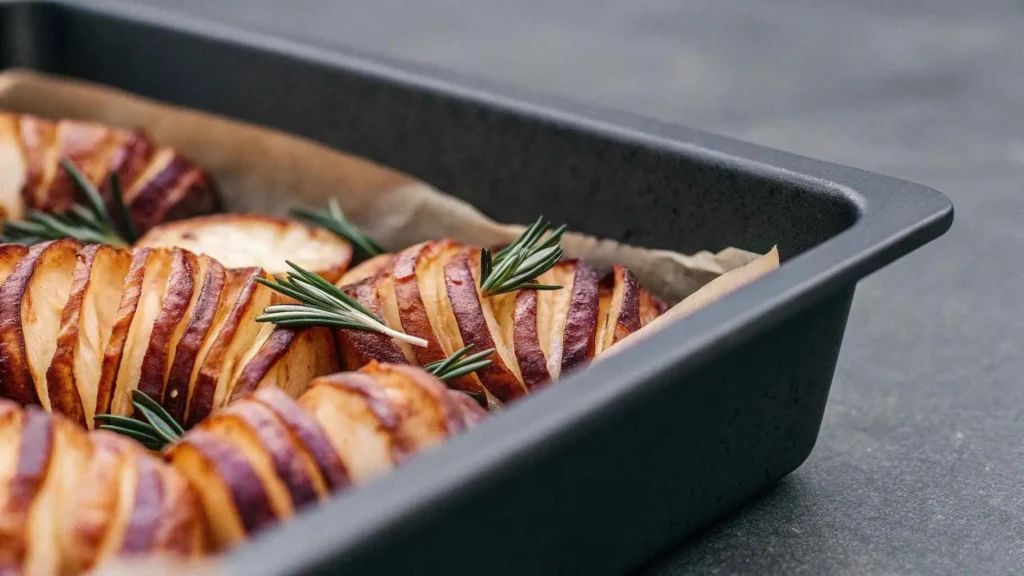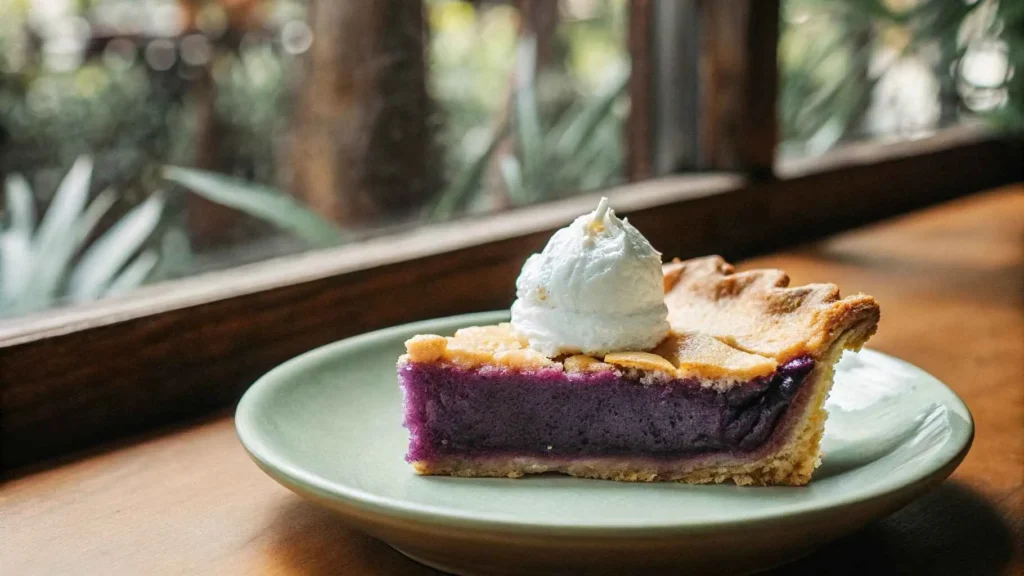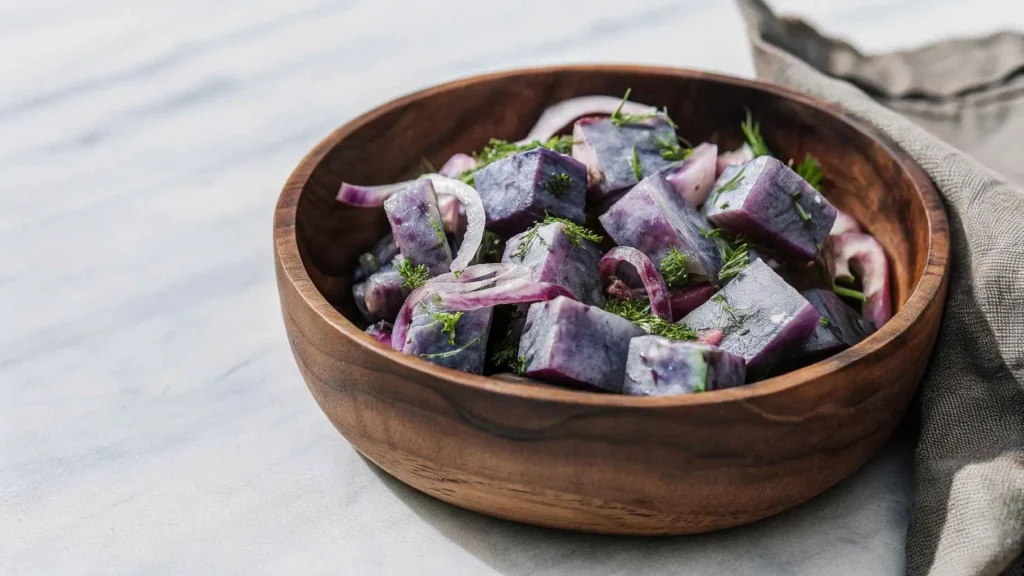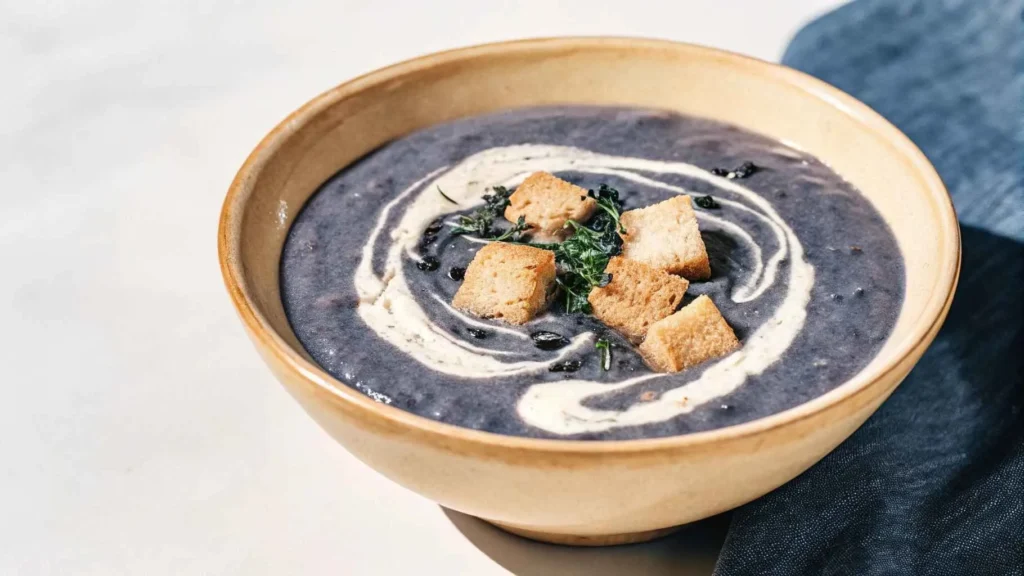Introduction
Purple potatoe are more than just a striking addition to your plate—they are a powerhouse of nutrition and flavor. With their deep violet hue and rich, earthy taste, these vibrant tubers have been cultivated for centuries, originating from the Andean regions of South America. Their intense color comes from anthocyanins, natural antioxidants that provide numerous health benefits, making them a sought-after superfood in modern diets.
As people become more health-conscious, purple potatoes are gaining popularity for their ability to support heart health, boost the immune system, and regulate blood sugar levels. Unlike traditional white or yellow potatoes, they offer a unique combination of fiber, vitamins, and antioxidants, making them a smart choice for those looking to enhance their meals with both color and nutrition.
Another reason for their rising demand is their versatility in cooking. Whether roasted to crispy perfection, mashed into a creamy side dish, or transformed into a silky soup, purple-potatoes can be enjoyed in countless ways. They are excellent in salads, stews, fries, and even desserts like the famous purple sweet potato pie. Whether you’re looking for a healthier alternative to regular potatoes or simply want to explore new flavors, purple potatoe are a fantastic ingredient to add to your kitchen.
In this guide, we’ll explore everything you need to know about purple-potatoes—from their health benefits and best cooking methods to delicious recipes and even tips on growing them at home. Let’s dive in!
Table of Contents
What Are Purple Potatoes?
Purple-potatoes are a unique variety of potatoes (Solanum tuberosum) that stand out for their deep purple skin and vibrant violet flesh. Unlike traditional white or yellow potatoes, these tubers owe their striking color to anthocyanins, a type of powerful antioxidant found in blueberries, red cabbage, and other deeply pigmented fruits and vegetables.
Origins and Different Types of Purple Potatoes
Purple-potatoes have been cultivated for centuries, originating in the Andean regions of Peru and Bolivia. Indigenous farmers first grew these nutrient-rich tubers at high altitudes, and they eventually spread to different parts of the world. Today, they are grown in North America, Europe, and Asia, where they are valued for both their taste and health benefits.
There are several varieties of purple-potatoes, each with slightly different flavors, textures, and uses:
- Purple Peruvian – A small, fingerling-shaped potato with a nutty, earthy flavor. Great for roasting and frying.
- Purple Majesty – A deep purple-skinned potato with a smooth texture and mildly sweet taste. Ideal for mashing or making fries.
- Vitelotte – A French heirloom variety known for its firm texture and deep violet color, which stays even after cooking. Perfect for chips and salads.
- Adirondack Blue – A vibrant potato with purple skin and blue-purple flesh. Its creamy texture makes it great for mashing and baking.
Purple Potatoes vs. Purple Sweet Potatoes
Although purple-potatoes and purple sweet potatoes share a similar color, they are not the same vegetable and belong to different plant families:
| Feature | Purple Potatoes | Purple Sweet Potatoes |
|---|---|---|
| Scientific Family | Nightshade (Solanaceae) | Morning Glory (Convolvulaceae) |
| Taste | Earthy, nutty, slightly savory | Sweet, mildly floral |
| Texture | Moist, creamy, sometimes waxy | Dense, starchy, drier |
| Best Uses | Roasting, boiling, mashing, frying | Baking, desserts, soups, pies |
Purple potatoes have a more traditional potato-like flavor, whereas purple sweet potatoes are sweeter, denser, and starchier, making them ideal for desserts like purple sweet potato pie.
The Power of Anthocyanins: Why Are Purple Potatoes So Colorful?
The deep purple hue of these potatoes comes from anthocyanins, a class of antioxidants responsible for protecting cells from damage, reducing inflammation, and supporting heart health. These compounds are the same pigments that give blueberries and red grapes their rich color and health benefits.
Consuming anthocyanin-rich foods like purple-potatoes has been linked to:
- Improved brain function and reduced risk of cognitive decline.
- Better heart health by lowering blood pressure and cholesterol.
- Stronger immune system due to their anti-inflammatory properties.
- Lower risk of diabetes by helping regulate blood sugar levels.
With their vibrant appearance, unique flavor, and powerful nutritional benefits, purple potatoes are an excellent addition to any diet. Whether you’re looking for a healthier alternative to white potatoes or simply want to experiment with exciting new flavors, these colorful tubers are worth trying!
Health Benefits of Purple Potatoes
Purple potatoes are not just a feast for the eyes; they also offer a wide array of health benefits that make them a valuable addition to any diet. Thanks to their unique composition of antioxidants, fiber, vitamins, and minerals, these potatoes are a true nutritional powerhouse. Here’s a breakdown of their top health benefits:
1. Rich in Antioxidants for Brain and Heart Health
One of the standout features of purple potatoes is their high concentration of anthocyanins—the natural antioxidants that give them their signature color. These potent compounds have been linked to a range of brain and heart health benefits, including:
- Improved cognitive function: Anthocyanins help protect brain cells from oxidative damage, potentially reducing the risk of cognitive decline and conditions like Alzheimer’s disease.
- Enhanced memory: Studies suggest that anthocyanins may support memory retention and overall brain function, making purple potatoes a great food for mental clarity.
- Reduced inflammation: The antioxidants in purple potatoes can help lower inflammation in the body, a factor that contributes to many chronic diseases, including heart disease.
By including purple-potatoes in your diet, you can benefit from these brain-boosting and heart-protective effects.
2. High Fiber Content for Digestion and Weight Management
Purple potatoes are an excellent source of dietary fiber, which is essential for maintaining a healthy digestive system. The fiber content helps to:
- Promote regular bowel movements: Fiber adds bulk to stool, preventing constipation and supporting overall digestive health.
- Improve gut health: A healthy gut microbiome is supported by fiber, which serves as food for beneficial gut bacteria.
- Aid in weight management: Fiber helps you feel fuller for longer, reducing hunger and preventing overeating. By adding purple-potatoes to your meals, you’ll feel satisfied without consuming excess calories.
With their high fiber content, purple potatoes are a smart choice for anyone looking to improve digestion or manage their weight.
3. Supports Blood Sugar Control with a Lower Glycemic Index
Unlike regular white potatoes, which have a higher glycemic index (GI), purple-potatoes have a lower GI. This means that they release sugar into the bloodstream more slowly, helping to maintain stable blood sugar levels. The benefits of a low-GI food include:
- Better blood sugar control: Eating purple-potatoes can help prevent spikes in blood sugar, making them an excellent choice for individuals with diabetes or those looking to manage their blood sugar.
- Reduced insulin resistance: Regular consumption of low-GI foods may improve the body’s sensitivity to insulin, helping to manage conditions like Type 2 diabetes.
- Sustained energy: Because purple-potatoes release energy more gradually, they can provide a steady source of fuel throughout the day, preventing the energy crashes that often follow high-GI foods.
By incorporating purple-potatoes into your meals, you can enjoy their benefits for blood sugar control while savoring their delicious taste.
4. Boosts Immune System with Vitamins and Minerals
Purple-potatoes are packed with essential vitamins and minerals that help support a strong immune system. These nutrients include:
- Vitamin C: A potent antioxidant that helps strengthen the immune system, fight infections, and promote wound healing.
- Potassium: An essential mineral that helps regulate fluid balance, maintain healthy blood pressure, and support muscle function.
- Vitamin B6: Plays a vital role in immune system function, supporting the production of red blood cells and maintaining proper nerve function.
- Iron: Helps produce hemoglobin, which carries oxygen throughout the body, and ensures healthy red blood cell production.
By adding purple potatoes to your diet, you’re not only benefiting from their antioxidant content, but you’re also boosting your body’s ability to fight illness and stay strong.
How to Cook Purple Potatoes
Purple potatoes are as versatile as they are nutritious, and there are several cooking methods to bring out their vibrant color and delicious flavor. Whether you’re looking to preserve their nutrients, enhance their taste, or create the perfect texture, understanding the best ways to cook them can make all the difference. Let’s explore the most common methods: roasting, boiling, steaming, and baking.
Best Cooking Methods to Retain Nutrients and Color
When cooking purple-potatoes, it’s important to retain as many nutrients as possible while preserving their rich, vibrant color. Here are some of the best practices for each cooking method:
- Roasting: Roasting is one of the best ways to preserve the antioxidants and nutrients in purple-potatoes. The high heat helps maintain the potato’s purple hue while bringing out its natural sweetness. To retain as much color as possible, avoid overcooking and use a high-heat method (around 400°F or 200°C).
- Boiling: Boiling purple potatoes can cause some loss of nutrients, particularly those found in the skin, but it is still a viable option for certain recipes. To preserve the color, try boiling them whole with the skins on. The skins act as a protective layer, keeping the potatoes’ color intact.
- Steaming: Steaming is an excellent method for retaining the most nutrients, as it doesn’t expose the potatoes to the direct heat of boiling water. The color also remains vibrant, and the potatoes stay tender without being waterlogged.
- Baking: Like roasting, baking helps maintain the integrity of the purple potatoes. Baking at a lower temperature (350°F or 175°C) helps preserve nutrients while allowing the potatoes to cook through evenly.
Comparison of Roasting, Boiling, Steaming, and Baking
| Cooking Method | Pros | Cons | Best For |
|---|---|---|---|
| Roasting | Retains flavor, crispy texture, vibrant color | Can dry out if overcooked | Roasting wedges, fries, or whole potatoes |
| Boiling | Simple, quick, good for mashed potatoes | Loses some nutrients and color | Mashed potatoes, soups, or stews |
| Steaming | Retains most nutrients, preserves color | Takes longer than boiling | Healthy sides, salads, or as a base for toppings |
| Baking | Even cooking, retains flavor and nutrients | Can take longer than other methods | Baked whole potatoes, casseroles, or stuffed potatoes |
Each cooking method offers unique benefits, depending on the type of dish you’re preparing. However, if preserving color and nutrients is your top priority, steaming or roasting are ideal options.
Tips on Seasoning to Enhance Their Natural Flavor
Purple potatoes have a naturally earthy, nutty flavor, but they can be easily enhanced with the right seasonings. Here are some tips for getting the best flavor out of your purple potatoes:
- Olive Oil and Garlic: A simple drizzle of olive oil with minced garlic brings out the rich flavor of purple potatoes. This is particularly good when roasting or steaming.
- Herbs and Spices: Purple potatoes pair wonderfully with rosemary, thyme, oregano, or parsley. Smoked paprika can add a subtle smokiness, while cumin or coriander can give them an extra touch of warmth.
- Salt and Pepper: Don’t underestimate the power of freshly ground black pepper and sea salt to enhance the natural flavor of purple potatoes. A little goes a long way.
- Vinegar or Lemon: A splash of apple cider vinegar or a squeeze of lemon can balance the potatoes’ natural sweetness and add brightness to the dish.
- Cheese: For mashed purple potatoes, adding a bit of parmesan or cheddar can complement their creamy texture and earthy taste.
By combining these simple seasonings, you can elevate the flavor of purple potatoes while still allowing their unique taste to shine through. Experiment with different herbs and spices based on the dish you’re creating!
Delicious Purple Potato Recipes
Purple potatoes are as versatile as they are nutritious, making them perfect for a variety of dishes—from savory sides to sweet treats. Here are some delicious purple potato recipes that you can easily prepare and enjoy:
A. Simple Roasted Purple Potatoes
Crispy, flavorful, and easy to make.
Ingredients:
- 4-5 medium purple potatoes, washed and cut into wedges
- 2 tbsp olive oil
- 2 cloves garlic, minced
- 1 tsp dried rosemary
- Salt and pepper, to taste
Instructions:
- Preheat the oven to 400°F (200°C).
- In a large bowl, toss the potato wedges with olive oil, garlic, rosemary, salt, and pepper.
- Arrange the potatoes in a single layer on a baking sheet lined with parchment paper.
- Roast for 25-30 minutes, flipping halfway through, until the potatoes are crispy on the outside and tender on the inside.
- Serve warm and enjoy as a delicious side dish or snack!

Why It Works: Roasting brings out the natural sweetness of purple-potatoes while giving them a crispy, golden texture. The garlic and rosemary complement their earthy flavor, making them a perfect addition to any meal.
B. Creamy Purple Mashed Potatoes
A colorful twist on a classic comfort dish.
Ingredients:
- 4-5 purple potatoes, peeled and cubed
- 1/4 cup unsalted butter (or dairy-free alternative)
- 1/2 cup milk (or non-dairy milk)
- 1/2 tsp salt
- 1/4 tsp black pepper
- 1/4 cup chives, chopped (optional)
Instructions:
- Bring a large pot of salted water to a boil and add the cubed purple potatoes.
- Cook for 15-20 minutes, or until the potatoes are fork-tender.
- Drain the potatoes and return them to the pot.
- Add butter, milk, salt, and pepper, and mash until smooth and creamy.
- Stir in chopped chives if desired, and adjust seasoning to taste.
- Serve warm as a side dish to your favorite main course.
Why It Works: The creamy texture of mashed potatoes combined with the vibrant purple color makes this dish visually stunning and comforting at the same time.
C. Purple Sweet Potato Pie
A naturally sweet and creamy dessert.
Ingredients:
- 2 medium purple sweet potatoes, peeled and cubed
- 1/2 cup coconut milk
- 1/2 cup maple syrup or honey
- 2 eggs
- 1 tsp ground cinnamon
- 1/2 tsp ground ginger
- 1/4 tsp ground nutmeg
- 1 tsp vanilla extract
- 1 pre-made pie crust (or homemade)
Instructions:
- Preheat the oven to 350°F (175°C).
- Steam or boil the purple sweet potatoes until soft, about 15-20 minutes.
- In a blender or food processor, combine the cooked sweet potatoes, coconut milk, maple syrup, eggs, cinnamon, ginger, nutmeg, and vanilla. Blend until smooth.
- Pour the mixture into the pie crust and smooth the top.
- Bake for 45-50 minutes, or until the filling is set and the crust is golden brown.
- Allow the pie to cool before slicing. Serve with whipped cream or a scoop of vanilla ice cream for a delightful dessert.

Why It Works: The naturally sweet and creamy texture of purple sweet potatoes makes them the perfect base for a rich pie filling. The combination of warm spices adds depth to the dessert, creating a comforting treat.
D. Purple Potato Salad with Herbs
A nutritious, colorful side dish.
Ingredients:
- 4-5 purple potatoes, boiled and cubed
- 1/4 cup olive oil
- 2 tbsp apple cider vinegar
- 1 tbsp Dijon mustard
- 1 tsp dried thyme
- 1/2 tsp salt
- 1/4 tsp black pepper
- 1/4 cup fresh parsley, chopped
- 1/4 cup red onion, finely chopped
Instructions:
- Boil the purple-potatoes until tender, about 15-20 minutes, then drain and allow them to cool slightly.
- In a small bowl, whisk together olive oil, vinegar, mustard, thyme, salt, and pepper.
- In a large bowl, combine the cubed potatoes, parsley, and red onion.
- Pour the dressing over the potatoes and toss gently to coat.
- Chill the salad in the refrigerator for at least 30 minutes before serving.

Why It Works: The vibrant purple color of the potatoes adds a fun twist to this classic side dish, while the fresh herbs and tangy dressing complement the creamy texture of the potatoes, making for a nutritious and visually stunning salad.
E. Purple Sweet Potato Soup
A rich, velvety soup perfect for any season.
Ingredients:
- 2 purple sweet potatoes, peeled and cubed
- 1 medium onion, chopped
- 2 cloves garlic, minced
- 1 tbsp olive oil
- 4 cups vegetable broth
- 1/2 tsp ground cumin
- 1/4 tsp ground cinnamon
- Salt and pepper, to taste
- 1/4 cup coconut milk (optional, for creaminess)
Instructions:
- In a large pot, heat olive oil over medium heat. Add the onion and garlic, and sauté until softened, about 5 minutes.
- Add the purple sweet potatoes, vegetable broth, cumin, cinnamon, salt, and pepper. Bring to a boil.
- Reduce the heat and simmer for 20-25 minutes, or until the sweet potatoes are tender.
- Use an immersion blender or regular blender to puree the soup until smooth and creamy.
- Stir in coconut milk for added richness (optional), then taste and adjust seasoning as needed.
- Serve warm with a sprinkle of fresh herbs or croutons.

Why It Works: This velvety soup is perfect for colder months, offering a creamy, comforting texture while still being light and nourishing. The spices add warmth, making this soup an excellent choice for any season.
Growing Purple Potatoes at Home
Growing your own purple potatoes can be a rewarding and fun experience, providing you with a healthy, nutrient-packed food right from your garden. Whether you’re an experienced gardener or a beginner, this step-by-step guide will walk you through planting, growing, and harvesting purple-potatoes with ease.
Step-by-Step Guide to Planting and Harvesting Purple Potatoes
1. Choosing the Right Seed Potatoes
To grow purple potatoes, you’ll need to start with seed potatoes (not regular grocery store potatoes). Seed potatoes are specifically grown for planting, free from disease and other issues. You can find purple seed potatoes at local garden centers or online.
Tip: Look for varieties like Purple Peruvian, Purple Majesty, or Adirondack Blue for the best results.
2. Preparing the Soil
Purple potatoes thrive in well-draining, loamy soil that is rich in organic matter. Follow these soil preparation steps:
- Soil pH: Aim for a slightly acidic soil pH of 5.5 to 6.5.
- Amend the soil: Mix in plenty of compost or well-rotted manure to improve fertility.
- Dig a trench: Prepare trenches about 6 to 8 inches deep. You can also plant your potatoes in raised beds or containers if you don’t have garden space.
3. Planting Your Purple Potatoes
- When to plant: Purple potatoes should be planted in early spring when the soil temperature is between 45°F and 55°F (7°C to 13°C).
- How to plant: Place your seed potatoes in the trench, spacing them about 12 inches apart. If the potatoes have eyes (small shoots), plant them eye-side up.
- Cover with soil: Gently cover the potatoes with soil, but don’t bury them too deep—about 4 to 6 inches of soil is sufficient.
4. Caring for Your Purple Potatoes
To ensure healthy growth, follow these best practices:
- Sunlight: Purple potatoes need full sun for at least 6 hours a day. Ensure your garden area receives plenty of direct sunlight.
- Watering: Keep the soil moist, but not waterlogged. Water the plants regularly, especially during dry spells, but make sure the soil drains well to prevent rot.
- Hilling: As your potato plants grow, periodically hill up the soil around the base of the plants to encourage the development of more tubers. This also helps protect the developing potatoes from sunlight, which can cause them to turn green.
- Fertilization: Fertilize your plants with a balanced, organic fertilizer every 4-6 weeks during the growing season to promote healthy growth.
5. Harvesting Your Purple Potatoes
- When to harvest: Purple-potatoes are typically ready for harvest in about 70 to 120 days, depending on the variety. The plants will start to yellow and die back when the potatoes are mature.
- How to harvest: Carefully dig around the base of the plant with a shovel or garden fork to lift the potatoes out of the soil. Be gentle to avoid damaging the tubers.
- Curing: After harvesting, allow the potatoes to cure in a cool, dark place for 1-2 weeks. This helps to toughen their skins and improves storage life.
Best Soil, Sunlight, and Watering Practices for Purple Potatoes
- Soil Type: Purple potatoes prefer well-draining, loose soil rich in organic matter. Heavy clay or poorly draining soils can lead to rot.
- Sunlight: They thrive in full sun, meaning at least 6-8 hours of direct sunlight per day.
- Watering: Water consistently, keeping the soil moist but not soggy. Purple-potatoes are sensitive to overwatering, so ensure proper drainage.
How to Store and Preserve Purple Potatoes
Once your purple-potatoes are harvested and cured, it’s important to store them properly to extend their shelf life. Here’s how to do it:
1. Storing Fresh Potatoes
- Ideal Storage Conditions: Store your purple potatoes in a cool, dark place—ideally between 45°F and 50°F (7°C to 10°C)—such as a root cellar, basement, or pantry.
- Avoid Light: Exposure to light causes potatoes to turn green, which makes them bitter and potentially toxic. Keep them in a paper bag or ventilated container to block light and ensure proper airflow.
- Don’t Refrigerate: Avoid storing potatoes in the fridge, as cold temperatures can convert the starches into sugars, affecting their taste and texture.
2. Freezing Purple Potatoes
Purple-potatoes can also be frozen if you want to store them for longer periods. Follow these steps:
- Blanching: Boil or steam the potatoes for a few minutes until just tender, then cool them rapidly by placing them in an ice bath.
- Freezing: After blanching, pat them dry and spread them on a baking sheet in a single layer. Freeze them for 1-2 hours, then transfer the potatoes to an airtight container or freezer bag for long-term storage.
3. Using Preserved Potatoes
Frozen purple-potatoes can be used in a variety of dishes, but be aware that they may become a bit softer when thawed. However, they are still perfect for mashed potatoes, soups, or stews.
Frequently Asked Questions About Purple Potatoes
1. Are purple potatoes healthier?
Yes, purple potatoes are considered healthier than regular white potatoes. They are rich in antioxidants, particularly anthocyanins, which give them their vibrant color and help combat oxidative stress in the body. Purple potatoes are also high in fiber, vitamins (like Vitamin C and B6), and minerals (such as potassium), making them a great addition to a nutrient-dense diet. Their lower glycemic index compared to white potatoes also supports better blood sugar control.
2. Do purple potatoes taste different?
Purple potatoes have a slightly earthy and nutty flavor, with some varieties offering a mild sweetness. The taste is somewhat similar to regular potatoes but tends to have a richer, more complex profile. Their texture is often creamier, especially when mashed, making them an excellent choice for various dishes.
3. What are purple potatoes called?
Purple potatoes are often referred to by specific varieties, such as Purple Peruvian, Purple Majesty, or Adirondack Blue. These varieties have slightly different characteristics, but all share the distinctive purple skin and flesh.
4. Is purple potato ube?
No, purple potatoes and ube (also known as purple yam) are different. While both are purple, ube is a type of yam, while purple potatoes are a variety of potato. Ube has a sweeter flavor and is commonly used in desserts, whereas purple potatoes are more savory.
Conclusion
Purple-potatoes are not just visually striking—they’re also packed with nutrients and offer numerous health benefits, making them a must-try addition to your diet. With their rich content of antioxidants, fiber, and essential vitamins, they’re an excellent choice for anyone looking to boost their overall health while enjoying delicious meals.
Whether you’re roasting, mashing, or incorporating them into unique dishes like purple sweet potato pie or purple potato salad, purple-potatoes offer endless possibilities for creativity in the kitchen. Their earthy flavor, vibrant color, and versatility make them a fun and nutritious ingredient to experiment with in both everyday meals and special occasions.
So, don’t hesitate—experiment with these colorful tubers and see how they can add both beauty and flavor to your culinary creations. Purple-potatoes are more than just a trend—they’re a healthy, delicious, and exciting way to elevate your dishes.


1 thought on “How To Make Purple Potatoes Recipes”
Comments are closed.